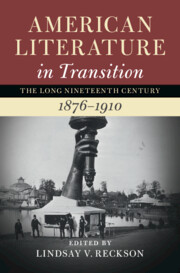Book contents
- American Literature in Transition, 1876–1910
- Nineteenth-Century American Literature in Transition
- American Literature in Transition, 1876–1910
- Copyright page
- Contents
- Contributors
- Series Preface
- Acknowledgments
- Chronology
- Introduction
- Part I Transitive States
- Part II Post-Reconstruction Aesthetics
- Part III Old Materialisms
- Part IV Immanent Techniques
- Chapter 15 Frances Harper’s Reconstruction
- Chapter 16 Emma Lazarus’s Cosmopolitanism
- Chapter 17 Henry James’s Temporalities
- Chapter 18 Charlotte Perkins Gilman’s Pragmatism
- Chapter 19 Nicholas Black Elk’s Cosmology (or, Post-Reconstructing Black Elk)
- Index
Chapter 17 - Henry James’s Temporalities
from Part IV - Immanent Techniques
Published online by Cambridge University Press: 24 August 2022
- American Literature in Transition, 1876–1910
- Nineteenth-Century American Literature in Transition
- American Literature in Transition, 1876–1910
- Copyright page
- Contents
- Contributors
- Series Preface
- Acknowledgments
- Chronology
- Introduction
- Part I Transitive States
- Part II Post-Reconstruction Aesthetics
- Part III Old Materialisms
- Part IV Immanent Techniques
- Chapter 15 Frances Harper’s Reconstruction
- Chapter 16 Emma Lazarus’s Cosmopolitanism
- Chapter 17 Henry James’s Temporalities
- Chapter 18 Charlotte Perkins Gilman’s Pragmatism
- Chapter 19 Nicholas Black Elk’s Cosmology (or, Post-Reconstructing Black Elk)
- Index
Summary
Henry James frequently makes you wait for it. Ask a frustrated reader and they are likely to tell you that James’s most overused narrative move is delay. The first sentence of The Wings of the Dove, for instance, signals a novel super-saturated with waiting: “She waited, Kate Croy, for her father to come in, but he kept her unconscionably, and there were moments at which she showed herself, in the glass over the mantel, a face positively pale with the irritation that had brought her to the point of going away without sight of him.”1 The odd form of the sentence forces its readers to wait for its subject (Kate) and then to wait with her for her father to arrive. The novel itself is structured as a long wait for the American heiress Milly Theale to die, to discover where her money will go. In James’s suspenseful novella, The Turn of the Screw, the governess’s time is one of constant vigilance. She waits to see the ghosts; she waits to see if she can discover if the children see the ghosts as well. She waits before she responds to questions and queries from the housekeeper Mrs. Grose, who also waits before pronouncing words and ideas that seem too frightening and terrible to say aloud. The frame narrative of the story similarly makes the story’s listeners/readers wait until Douglas’s narrative can be delivered. It appears there are some stories, some words, that can only be said after a long build-up.
- Type
- Chapter
- Information
- American Literature in Transition, 1876–1910 , pp. 324 - 344Publisher: Cambridge University PressPrint publication year: 2022



